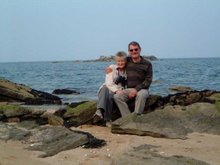We have an 8:00 am departure. It’s the longest day’s journey and we’ll be travelling along the Gallipoli peninsula before crossing the Dardanelles strait into Asia. Along the way we’ll be calling in at some of the locations that saw the fiercest action in the First World War Gallipoli campaign of 1915.
The weather’s not great again but it maybe suits the sombre
settings where men lost their lives in 1915. Just before getting to the
battlegrounds we have lunch at the waterside. We hope the approaching ferry has
good brakes.
Turkey entered the Great War on Germany’s side, but we wanted to send supplies to our ally Russia through the Bosphorous/ Dardanelles straits, because Russia’s northern ports were frozen solid for much of the year.
Churchill, who was First Lord of the Admiralty, felt he had the solution: our navy would force the straits, bombard Istanbul and force Turkey into surrender. We could then send unrestricted supplies to Russia.
So in March 1915 the Royal Navy, with French support, started cruising up the Dardanelles. There was no opposition: unbeknown to the taskforce the Turks had run out of ammunition. However, the ships struck mines and three battleships were sunk and three more vessels damaged. So they withdrew and waited a short distance away. The Turks guessed another assault was coming so hurriedly scraped together ammunition and reinforcements. The Turks were fortunate in having an exceptional commander, Mustafa Kemal, who later became premier of the new Turkish Republic in 1923.
Our attack came on 25th April when 16,000 soldiers, many of them Australian and New Zealand troops, stormed the beaches. Initially taken by surprise the Turks fell back, but allied commanders failed to press the advantage and both sides dug in. The landing beaches were short and finding cover difficult, as can be seen at what is now called Anzac Cove.
This is the ridge looming over the cove which gave the Turks
a commanding position. It didn’t help that the allied troops named the rock outcrop
the Sphynx and believed it a bad omen.
More landings took place, with a final push on 6th August, but these were all pinned down as well. As the year continued the War Cabinet in London realised that the enterprise was going nowhere and ordered an evacuation. This was completed by January 1916 with no casualties: the Turks just let them go without further violence.
Altogether, the allies fatalities amounted to nearly 57,000,
the Turks 85,000. These are commemorated by war graves, such as this:
And also memorials. This one marks the landings in Turkish,
erected after the war on the orders of president Mustapha Kemal. The tour
member with his backpack by the Turkish flag could be the unknown soldier.
The weather turns wetter and we head back to the shelter of the bus. You can see that the bus itself is first class and very comfortable.
A short while later we cross the straits by bridge onto the
Asian side, then on to our hotel at Canakkale.







No comments:
Post a Comment